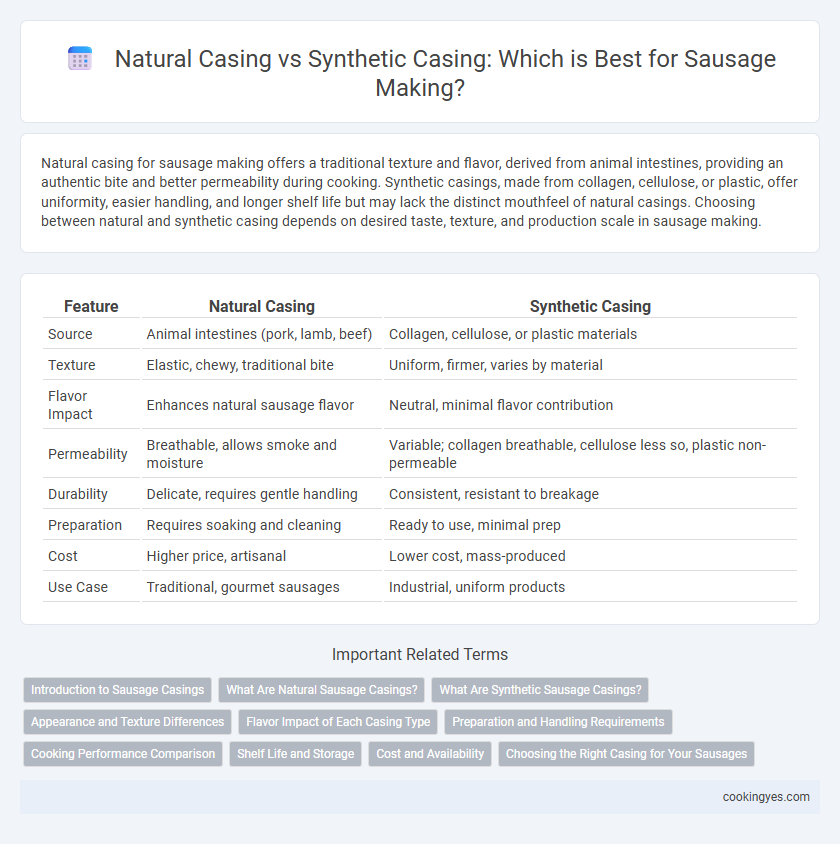Natural casing for sausage making offers a traditional texture and flavor, derived from animal intestines, providing an authentic bite and better permeability during cooking. Synthetic casings, made from collagen, cellulose, or plastic, offer uniformity, easier handling, and longer shelf life but may lack the distinct mouthfeel of natural casings. Choosing between natural and synthetic casing depends on desired taste, texture, and production scale in sausage making.
Table of Comparison
| Feature | Natural Casing | Synthetic Casing |
|---|---|---|
| Source | Animal intestines (pork, lamb, beef) | Collagen, cellulose, or plastic materials |
| Texture | Elastic, chewy, traditional bite | Uniform, firmer, varies by material |
| Flavor Impact | Enhances natural sausage flavor | Neutral, minimal flavor contribution |
| Permeability | Breathable, allows smoke and moisture | Variable; collagen breathable, cellulose less so, plastic non-permeable |
| Durability | Delicate, requires gentle handling | Consistent, resistant to breakage |
| Preparation | Requires soaking and cleaning | Ready to use, minimal prep |
| Cost | Higher price, artisanal | Lower cost, mass-produced |
| Use Case | Traditional, gourmet sausages | Industrial, uniform products |
Introduction to Sausage Casings
Natural casings, derived from the intestines of animals such as pigs, sheep, and cows, offer a traditional texture and flavor preferred in artisanal sausage making. Synthetic casings, made from materials like collagen, cellulose, or plastic, provide uniformity, durability, and ease of use, especially for large-scale production. Choosing between natural and synthetic casings depends on factors like desired bite, sausage type, and processing requirements.
What Are Natural Sausage Casings?
Natural sausage casings are made from the cleaned intestines of animals such as pigs, sheep, and cows, providing an edible and biodegradable casing that enhances the texture and flavor of sausages. These casings offer superior permeability, allowing smoke and seasoning to penetrate the sausage during cooking and curing processes. Preferred in traditional and artisanal sausage making, natural casings deliver a characteristic snap and appearance that synthetic alternatives often lack.
What Are Synthetic Sausage Casings?
Synthetic sausage casings are man-made casings created from materials such as collagen, cellulose, or plastic, designed to replace traditional natural casings derived from animal intestines. These casings offer uniformity in size and shape, enhanced durability, and consistent performance during the sausage making process, making them ideal for mass production. Collagen casings are edible and often used for fresh and smoked sausages, while cellulose and plastic casings are generally non-edible and used for skinless sausages or processed meats.
Appearance and Texture Differences
Natural casings, made from animal intestines, provide a traditional, irregular appearance and a tender, chewy texture that enhances the sausage-eating experience. Synthetic casings, typically composed of collagen or cellulose, offer a uniform, smooth exterior and a firmer bite, ideal for consistent sizing and industrial production. The choice between natural and synthetic casings significantly impacts the visual appeal and mouthfeel of the final sausage product.
Flavor Impact of Each Casing Type
Natural casings, made from animal intestines, enhance sausage flavor by allowing natural smoke and spices to permeate, creating a traditional, authentic taste with a tender bite. Synthetic casings, often composed of collagen or cellulose, tend to have a neutral flavor impact but provide consistent shape and easier handling, which may result in a milder overall sausage profile. The permeability of natural casings contributes to more intense flavor development compared to the barrier effect of synthetic casings.
Preparation and Handling Requirements
Natural casings require thorough rinsing and soaking in warm water to remove excess salt and ensure pliability, while synthetic casings often need hydration or conditioning based on material type. Handling natural casings demands careful inspection for tears and requires gentle stuffing to prevent rupture, contrasting with synthetic casings that offer consistent strength and easier handling during the stuffing process. Both casing types benefit from proper storage, with natural casings refrigerated or frozen to maintain quality, whereas synthetic casings typically have a longer shelf life at room temperature.
Cooking Performance Comparison
Natural casings offer superior breathability, allowing smoke and flavors to penetrate evenly, resulting in a more authentic texture and taste during cooking. Synthetic casings provide consistent thickness and uniform shrinkage, enhancing cooking control and preserving sausage shape under high heat. Both casing types impact moisture retention and cooking time but natural casings generally yield juicier results, while synthetic casings excel in durability and ease of handling.
Shelf Life and Storage
Natural sausage casings, made from animal intestines, offer excellent permeability that aids in moisture regulation but generally have a shorter shelf life of around 6 to 12 months when properly refrigerated. Synthetic casings, composed of collagen, cellulose, or plastic, provide extended shelf stability lasting up to 18 months or more under optimal storage conditions due to their uniform barrier properties. Storage requirements for natural casings necessitate refrigeration or freezing to prevent spoilage, while synthetic casings can often be stored at room temperature, enhancing convenience and reducing the risk of microbial growth during shelf life.
Cost and Availability
Natural casings, derived from animal intestines, tend to be more expensive and subject to fluctuations in availability due to sourcing challenges and seasonal variations. Synthetic casings, made from collagen, cellulose, or plastic, offer more consistent pricing and widespread availability, making them a cost-effective option for large-scale sausage production. While natural casings provide traditional texture and permeability, synthetic alternatives dominate the market because of their reliability and affordability.
Choosing the Right Casing for Your Sausages
Natural casings, derived from the intestines of animals, offer superior flavor and texture, providing a traditional snap that enhances the sausage-eating experience. Synthetic casings, made from collagen, cellulose, or plastic, provide uniformity, ease of use, and durability, ideal for consistent product size and commercial sausage production. Selecting the right casing depends on factors such as desired taste, sausage type, cooking method, and production scale, with natural casings preferred for artisanal sausages and synthetic casings favored for efficiency and shelf stability.
Natural casing vs synthetic casing for sausage making Infographic

 cookingyes.com
cookingyes.com